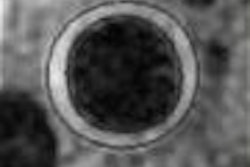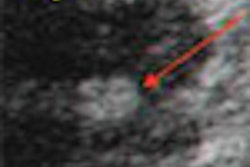An alternative Doppler index may be more accurate that traditional ultrasound parameters for diagnosing patients with renal artery stenosis, according to a new study by researchers from Argentina.
"We developed this index with two classic direct parameters: renal systolic velocity and the renal aortic ratio. This is a new index based on the ratio between these two," explained Dr. Sergio Chain, lead investigator and assistant professor of cardiology at the Centro Modelo de Cardiologia in Tucuman, Argentina.
His group's study found the newly dubbed renal-renal index (RRI) fared well in comparison with the two traditional parameters of renal peak systolic velocity (RPSV) and renal aortic ratio (RAR).
"This index has a higher sensitivity compared with the other traditional parameters," along with "significant specificity which does not decrease the sensitivity in the imaging," Chain stated.
Chain and his colleagues presented their findings at the recent American College of Cardiology (ACC) meeting in Orlando, FL.
For this preliminary study, Chain's team enrolled 34 patients diagnosed with severe arterial hypertension. Renal artery stenosis is one of the main causes of such secondary hypertension.
Each patient underwent angiography as the gold standard, with renal aortic stenosis defined as a greater than 70% reduction in the diameter of the artery.
They then compared the RPSV and RAR with their proposed RRI.
RPSV was measured as the highest systolic Doppler velocity at the main renal artery. Stenosis was considered significant when the RPSV was greater than 200 cm/sec.
RAR was measured as the rate between RPSV and the aortic peak systolic velocity measured at the abdominal aorta. Stenosis was considered significant at a ratio greater than 3.
The new RRI is the rate between RPSV and the RPSV measured at the renal hilum in its extraparenchymal segment, the researchers reported. The researchers found the optimal sensitivity and specificity cutoff for the new RRI was at greater than 2.7.
Investigators found the RRI's performance was much better than the competing parameters in terms of sensitivity, specificity, positive predictive value (PPV), and negative predictive value (NPV), as shown below.
|
"This index may present an opportunity for better diagnosis of patients," Chain concluded. "We are doing more diagnosis of renal stenosis (in our facility). Over the course of time we are finding that diagnosis is improved considerably with this new index."
By Jerry Ingram
AuntMinnie.com contributing writer
March 23, 2005
Related Reading
Color Doppler US better than scintigraphy for screening RAS, December 2, 2004
Study finds link between RAS and cardiovascular disease risk, April 19, 2004
Brazilian sonologists offer technique for suspected RAS, June 6, 2003
Extent of coronary disease predicts presence of renal artery stenosis, November 14, 2002
Copyright © 2005 AuntMinnie.com



















